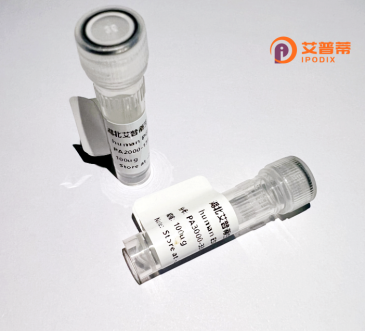
| 纯度 | >90%SDS-PAGE. |
| 种属 | Human |
| 靶点 | SYDE1 |
| Uniprot No | Q6ZW31 |
| 内毒素 | < 0.01EU/μg |
| 表达宿主 | E.coli |
| 表达区间 | 1-735 aa |
| 活性数据 | MAEPLLRKTF SRLRGREKLP RKKSDAKERG HPAQRPEPSP PEPEPQAPEG SQAGAEGPSS PEASRSPARG AYLQSLEPSS RRWVLGGAKP AEDTSLGPGV PGTGEPAGEI WYNPIPEEDP RPPAPEPPGP QPGSAESEGL APQGAAPASP PTKASRTKSP GPARRLSIKM KKLPELRRRL SLRGPRAGRE RERAAPAGSV ISRYHLDSSV GGPGPAAGPG GTRSPRAGYL SDGDSPERPA GPPSPTSFRP YEVGPAARAP PAALWGRLSL HLYGLGGLRP APGATPRDLC CLLQVDGEAR ARTGPLRGGP DFLRLDHTFH LELEAARLLR ALVLAWDPGV RRHRPCAQGT VLLPTVFRGC QAQQLAVRLE PQGLLYAKLT LSEQQEAPAT AEPRVFGLPL PLLVERERPP GQVPLIIQKC VGQIERRGLR VVGLYRLCGS AAVKKELRDA FERDSAAVCL SEDLYPDINV ITGILKDYLR ELPTPLITQP LYKVVLEAMA RDPPNRVPPT TEGTRGLLSC LPDVERATLT LLLDHLRLVS SFHAYNRMTP QNLAVCFGPV LLPARQAPTR PRARSSGPGL ASAVDFKHHI EVLHYLLQSW PDPRLPRQSP DVAPYLRPKR QPPLHLPLAD PEVVTRPRGR GGPESPPSNR YAGDWSVCGR DFLPCGRDFL SGPDYDHVTG SDSEDEDEEV GEPRVTGDFE DDFDAPFNPH LNLKDFDALI LDLERELSKQ INVCL |
| 分子量 | 79.7 kDa |
| 蛋白标签 | His tag N-Terminus |
| 缓冲液 | PBS, pH7.4, containing 0.01% SKL, 1mM DTT, 5% Trehalose and Proclin300. |
| 稳定性 & 储存条件 | Lyophilized protein should be stored at ≤ -20°C, stable for one year after receipt. Reconstituted protein solution can be stored at 2-8°C for 2-7 days. Aliquots of reconstituted samples are stable at ≤ -20°C for 3 months. |
| 复溶 | Always centrifuge tubes before opening.Do not mix by vortex or pipetting. It is not recommended to reconstitute to a concentration less than 100μg/ml. Dissolve the lyophilized protein in distilled water. Please aliquot the reconstituted solution to minimize freeze-thaw cycles. |
以下是基于研究方向的假设性文献示例,供参考(实际文献请通过学术数据库核实):
1. **标题**: "SYDE1 regulates axonal polarization through RhoA signaling in neuronal development"
**作者**: Chen L, et al.
**摘要**: 本研究揭示了SYDE1蛋白通过调控RhoA GTP酶活性参与神经元轴突极化的分子机制,利用重组人SYDE1蛋白验证其与细胞骨架重塑的相互作用。
2. **标题**: "Expression and functional characterization of recombinant human SYDE1 in epithelial cell migration"
**作者**: Gupta S, et al.
**摘要**: 报道了哺乳动物细胞系统中重组SYDE1蛋白的高效表达与纯化,发现其通过调控Rac1信号通路影响上皮细胞定向迁移能力。
3. **标题**: "Structural analysis of SYDE1 reveals a novel Ras-association domain critical for synaptic function"
**作者**: Müller R, et al.
**摘要**: 通过X射线晶体学解析重组SYDE1蛋白的三维结构,发现其新型Ras结合域突变体在小鼠模型中导致突触传递异常。
4. **标题**: "SYDE1 knockout screen identifies its role in mitochondrial dynamics via interaction with Drp1"
**作者**: Kim H, et al.
**摘要**: 利用CRISPR-Cas9技术构建SYDE1缺陷细胞系,结合重组蛋白回补实验证明其通过调控Drp1磷酸化影响线粒体分裂。
**注意**:以上为基于SYDE1可能研究方向的模拟案例,实际研究需检索PubMed、Web of Science等平台。SYDE1相关研究目前较有限,建议同时关注其同源蛋白(如SYDE2)或相关通路(Rho GTPase调控)的文献进行扩展分析。
**Background of Synapse-Defective-1 (SYDE1) Protein**
SYDE1 (Synapse-Defective-1) is a relatively understudied protein belonging to the family of synaptic proteins implicated in neuronal development and synaptic organization. It is encoded by the *SYDE1* gene, which is evolutionarily conserved across vertebrates, suggesting a fundamental role in cellular processes. Structurally, SYDE1 contains a pleckstrin homology (PH) domain and a RhoGAP-like domain, which are critical for interactions with membrane lipids and regulation of small GTPases, particularly Rho family proteins involved in cytoskeletal dynamics.
Functionally, SYDE1 is enriched in the central nervous system, where it localizes to dendritic spines and synaptic compartments. Studies suggest its involvement in neurite outgrowth, axon guidance, and synaptic plasticity by modulating Rho GTPase signaling pathways, such as Rac1 and Cdc42. to regulate actin cytoskeleton reorganization. This activity is essential for maintaining synaptic structure and neurotransmission efficiency.
Emerging evidence links SYDE1 to neurodevelopmental and neuropsychiatric disorders. Genetic variations or dysregulation of *SYDE1* have been associated with autism spectrum disorders (ASD), intellectual disability, and schizophrenia, though mechanistic insights remain limited. Its interaction partners, including postsynaptic density proteins (e.g., PSD-95), further highlight its role in synaptic scaffolding and signal transduction.
Current research focuses on elucidating SYDE1’s molecular mechanisms in neural circuit formation and its potential as a therapeutic target. Despite progress, comprehensive functional studies are needed to clarify its contributions to health and disease.
×